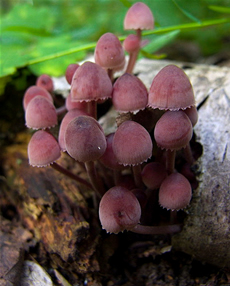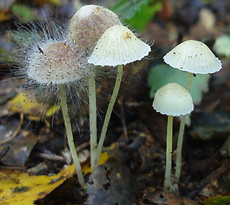Agriculture
Zygomycetes are a group of fungi that constitute the phylum Zygomycota. Also called zygote fungi, zygomycetes include about 750 species.
Most are saprobes, living on decaying plant and animal matter in the soil; some are parasites of plants, of insects, or of small soil animals; some cause the familiar soft fruit rot and black breadmold; and a fewoccasionally cause severe infections in humans and farm animals.
Zygomycetes sharemany common features with members of other phyla in kingdom Fungi. They are rapidly growing, nonphotosynthetic organisms that characteristically form filaments called hyphae.
Hyphae are highly branched to form an interwoven network mass called mycelium. All zygomycetes are terrestrial and reproduce by means of spores. No motile cells are formed at any stage of their life cycle.
The primary component of their cell wall is chitin, and the primary storage polysaccharide in the cytoplasm is glycogen. Most zygomycetes have coenocytic hyphae, within which the cytoplasm can frequently be seen streaming rapidly. Both sexual and asexual reproduction occurs in zygomycetes.
Members of Zygomycota play important roles both ecologically and economically. Some species (such as Rhizopus stolonifer) cause soft fruit rot, posing a problem for transport and storage of many fruits.
The same fungi may also feed on bread and other bakery foods, a potentially serious health hazard. Others, such as Glomus versiforme, may form intimate and mutually beneficial symbiotic associations with plant roots called mycorrhizae (literally, ?fungus roots?).
Yet another group of zygomycetes, the trichomycetes, form a fascinating relationship with arthropods. Trichomycetes are found in the larvae of aquatic insects,millipedes, crayfish, and even crustaceans living at the bottom of the ocean near hydrothermal vents. They usually reside in the guts of these animals and are thought to provide vitamins to their hosts.
Members of zygomycetes in the order of Entomophthorales have great ecological significance based on their parasitic relation with insects and other small pest animals. They are being increasingly used in the biological control of insect pests of crops.
Reproduction and Life Cycle
Even though by appearance all haploid hyphae of zygomycetes look identical, they are actually of two different mating types. When the two hyphae are in close proximity, hormones are released that cause an outgrowth near their hyphal tips to come together and develop into gametangia.
Although some species are homothallic (self-fertilizing),most Zycomycota species are heterothallic, requiring a combination of + and ? strains for sexual reproduction. The two strains ?mate? sexually through the combination of two gametangia.
In the process, the walls between the two touching gametangia dissolve, fusing their haploid nuclei to form diploid zygospores (hence the name Zycomycota for this phylum). Zygospores have very thick walls and thus are very hardy, able to tolerate extreme environment conditions. Zygospores are dispersed through the air and can remain dormant until conditions are favorable for growth.
Zygospores then undergo meiosis and germinate, producing structures on which sporangia (spore cases) are formed. The sporangia produce and disperse numerous haploid spores, marking the beginning of the asexual part of the reproductive cycle.
During asexual reproduction, haploid spores released by sporangia germinate on food such as fruits, bread, and dung, producing haploid hyphae. These hyphae in turnmay producemore hyphae or additional spores within sporangia through mitosis, and the cycle begins again.
Asexual reproduction via haploid spores of sporangia is universal among all species of zygomycetes. Two examples illustrate the important role of zygomycetes in human lives:Rhizopus stolonifer andGlomus versiforme.
Rhizopus stolonifer
This is one of the best-known and most familiar members of phylumZygomycota. Rhizopus stolonifer is a black mold that forms cottony masses on the surfaces ofmoist, carbohydrate-rich foods and similar substances that are exposed to air.
This organismis a serious pest for stored fruits and vegetables, bread, and other types of staple food.Many people are familiarwith rotten fruits or aged bread that are covered by R. stolonifer.
The life cycle of R. stolonifer is similar to those of other species of Zygomycota. The mycelium of R. stolonifer is composed of several distinct types of haploid hyphae.
Most of the mycelium consists of rapidly growing, coenocytic hyphae, which grow through the substrate (such as orange or bread), absorbing nutrients. From coenocytic hyphae, arching hyphae called stolons are formed. The stolons formrhizoidswherever their tips come into contact with the substrate.
From each of these points, a sturdy, erect branch arises,which is called a sporangiophore. Each sporangiphore produces a spherical sporangiumat its apex.Asporangiumbegins as a swelling sac, intowhich a number of nuclei flow.
The sporangium is eventually isolated from other hyphae by the formation of a structure called a septum. The protoplasm within is cleaved, and a cellwall forms around each spore. The sporangium wall becomes black as it matures, giving the mold its characteristic color.
Each mature spore, upon dispersal, is capable of germinating under adequate conditions to produce a newmycelium. Each year R. stolonifer causes an estimated loss of millions of dollars to farmers, fruit growers, and consumers.
Glomus versiforme and Mycorrhizae
As one of the most important groups of zygomycetes,Glomus versiforme andrelatedgenera grow in intimate associations with the roots of plants, forming mycorrhizae.
Mycorrhizae not only dramatically increase the surface area of roots for absorption but also help convert nutrients in soil into forms usable by plants. For many forest trees, if seedlings are grown in a sterile nutrient solution and then transplanted to grassland soil, they grow poorly and may eventually die from malnutrition.
However, if a small amount of forest soil containing the appropriate fungi (including G. versiforme)is added to the soil around the roots of the seedlings, normal growth is restored. Studies have found that in forest soil G. versiforme and related fungi ensure the formation of mycorrhizae and restore the normal growth of seedlings.
Mycorrhizae occur in most groups of vascular plants. The fungal partner G. versiforme helps plant roots to absorb and transfer essential nutrients such as phosphorus, zinc, manganese, and copper.
By extending several centimeters out from colonized roots in all directions, the plants are able to obtain nutrients from a much larger volume of soil than would be possible otherwise. In return, G. versiforme obtains carbohydrates from the host plants.
Some fungi may simply attach to the outer surface of the root to form a sheath of hyphae around the root called ectomycorrhizae. In addition to surface extension, other fungi may penetrate into the root to form endomycorrhizae.
Of the two major types of mycorrhizae, endomycorrhizae occur in about 80 percent of all vascular plants. The G. versiforme hyphae penetrate the cortical cells of the plant root, where they form either minute, highly branched, treelike structures called arbuscules or swellings called vesicles.
Such endomycorrhizae are particularly important in the tropics,where soils tend to be positively charged and thus retain phosphates so tightly that this nutrient is available only in very limited supplies for plant growth.
Since the impoverished farmers there are often unable to afford fertilizers, endomycorrhizae play a critical role in making phosphates available to crops in these regions. The commercial applications of endomycorrhizae to crops in other regions to reduce fertilizer use and increase yields appear to be an increasingly attractive possibility as well.
- Ascomycetes
Ascomycetes The ascomycetes are fungi (phylum Ascomycota or Ascomycotina) that produce sexual spores in a specialized cell called an ascus. These diverse fungi, with more than thirty thousand species, can be found in almost every ecosystem worldwide....
- Basidioporic Fungi
Basidioporic FungiBasidiosporic fungi (also known as the Basidiomycota or Basidiomycotina) are fungi that produce sexual spores on a specialized cell called a basidium. The basidiosporic fungi are the most diverse phylum of the fungi world, with more...
- Deuteromycetes
DeuteromycetesDeuteromycetes are an artificial group of fungi, of which there exist approximately fifteen thousand species, often referred to as ?fungi imperfecti? because their only known reproductive mechanism is asexual. Deuteromycetes?also known as...
- Fungi
FungiThe kingdom of non photosynthetic eukaryotic organisms, fungi are heterotrophic organisms, feeding on other materials rather than making their own food. They live on dead organisms by secreting digestive enzymes and absorbing the breakdown products....
- Mitosporic Fungi
Mitosporic FungiMitosporic fungi?also known as Deuteromycota, Deuteromycotina, fungi imperfecti, and deuteromycetes?are fungi that are unable to produce sexual spores and are therefore placed in a separate phylum. The term ?mitosporic? is a combination...
Agriculture
Zygomycetes
 |
| Zygomycetes |
Most are saprobes, living on decaying plant and animal matter in the soil; some are parasites of plants, of insects, or of small soil animals; some cause the familiar soft fruit rot and black breadmold; and a fewoccasionally cause severe infections in humans and farm animals.
Zygomycetes sharemany common features with members of other phyla in kingdom Fungi. They are rapidly growing, nonphotosynthetic organisms that characteristically form filaments called hyphae.
Hyphae are highly branched to form an interwoven network mass called mycelium. All zygomycetes are terrestrial and reproduce by means of spores. No motile cells are formed at any stage of their life cycle.
The primary component of their cell wall is chitin, and the primary storage polysaccharide in the cytoplasm is glycogen. Most zygomycetes have coenocytic hyphae, within which the cytoplasm can frequently be seen streaming rapidly. Both sexual and asexual reproduction occurs in zygomycetes.
Members of Zygomycota play important roles both ecologically and economically. Some species (such as Rhizopus stolonifer) cause soft fruit rot, posing a problem for transport and storage of many fruits.
|
 |
The same fungi may also feed on bread and other bakery foods, a potentially serious health hazard. Others, such as Glomus versiforme, may form intimate and mutually beneficial symbiotic associations with plant roots called mycorrhizae (literally, ?fungus roots?).
Yet another group of zygomycetes, the trichomycetes, form a fascinating relationship with arthropods. Trichomycetes are found in the larvae of aquatic insects,millipedes, crayfish, and even crustaceans living at the bottom of the ocean near hydrothermal vents. They usually reside in the guts of these animals and are thought to provide vitamins to their hosts.
Members of zygomycetes in the order of Entomophthorales have great ecological significance based on their parasitic relation with insects and other small pest animals. They are being increasingly used in the biological control of insect pests of crops.
Reproduction and Life Cycle
 |
| Zygomycetes Reproduction and Life Cycle |
Although some species are homothallic (self-fertilizing),most Zycomycota species are heterothallic, requiring a combination of + and ? strains for sexual reproduction. The two strains ?mate? sexually through the combination of two gametangia.
In the process, the walls between the two touching gametangia dissolve, fusing their haploid nuclei to form diploid zygospores (hence the name Zycomycota for this phylum). Zygospores have very thick walls and thus are very hardy, able to tolerate extreme environment conditions. Zygospores are dispersed through the air and can remain dormant until conditions are favorable for growth.
Zygospores then undergo meiosis and germinate, producing structures on which sporangia (spore cases) are formed. The sporangia produce and disperse numerous haploid spores, marking the beginning of the asexual part of the reproductive cycle.
During asexual reproduction, haploid spores released by sporangia germinate on food such as fruits, bread, and dung, producing haploid hyphae. These hyphae in turnmay producemore hyphae or additional spores within sporangia through mitosis, and the cycle begins again.
Asexual reproduction via haploid spores of sporangia is universal among all species of zygomycetes. Two examples illustrate the important role of zygomycetes in human lives:Rhizopus stolonifer andGlomus versiforme.
Rhizopus stolonifer
This is one of the best-known and most familiar members of phylumZygomycota. Rhizopus stolonifer is a black mold that forms cottony masses on the surfaces ofmoist, carbohydrate-rich foods and similar substances that are exposed to air.
This organismis a serious pest for stored fruits and vegetables, bread, and other types of staple food.Many people are familiarwith rotten fruits or aged bread that are covered by R. stolonifer.
The life cycle of R. stolonifer is similar to those of other species of Zygomycota. The mycelium of R. stolonifer is composed of several distinct types of haploid hyphae.
Most of the mycelium consists of rapidly growing, coenocytic hyphae, which grow through the substrate (such as orange or bread), absorbing nutrients. From coenocytic hyphae, arching hyphae called stolons are formed. The stolons formrhizoidswherever their tips come into contact with the substrate.
From each of these points, a sturdy, erect branch arises,which is called a sporangiophore. Each sporangiphore produces a spherical sporangiumat its apex.Asporangiumbegins as a swelling sac, intowhich a number of nuclei flow.
The sporangium is eventually isolated from other hyphae by the formation of a structure called a septum. The protoplasm within is cleaved, and a cellwall forms around each spore. The sporangium wall becomes black as it matures, giving the mold its characteristic color.
Each mature spore, upon dispersal, is capable of germinating under adequate conditions to produce a newmycelium. Each year R. stolonifer causes an estimated loss of millions of dollars to farmers, fruit growers, and consumers.
Glomus versiforme and Mycorrhizae
 |
| Mushroom Growing 4 You |
Mycorrhizae not only dramatically increase the surface area of roots for absorption but also help convert nutrients in soil into forms usable by plants. For many forest trees, if seedlings are grown in a sterile nutrient solution and then transplanted to grassland soil, they grow poorly and may eventually die from malnutrition.
However, if a small amount of forest soil containing the appropriate fungi (including G. versiforme)is added to the soil around the roots of the seedlings, normal growth is restored. Studies have found that in forest soil G. versiforme and related fungi ensure the formation of mycorrhizae and restore the normal growth of seedlings.
Mycorrhizae occur in most groups of vascular plants. The fungal partner G. versiforme helps plant roots to absorb and transfer essential nutrients such as phosphorus, zinc, manganese, and copper.
By extending several centimeters out from colonized roots in all directions, the plants are able to obtain nutrients from a much larger volume of soil than would be possible otherwise. In return, G. versiforme obtains carbohydrates from the host plants.
Some fungi may simply attach to the outer surface of the root to form a sheath of hyphae around the root called ectomycorrhizae. In addition to surface extension, other fungi may penetrate into the root to form endomycorrhizae.
Of the two major types of mycorrhizae, endomycorrhizae occur in about 80 percent of all vascular plants. The G. versiforme hyphae penetrate the cortical cells of the plant root, where they form either minute, highly branched, treelike structures called arbuscules or swellings called vesicles.
Such endomycorrhizae are particularly important in the tropics,where soils tend to be positively charged and thus retain phosphates so tightly that this nutrient is available only in very limited supplies for plant growth.
Since the impoverished farmers there are often unable to afford fertilizers, endomycorrhizae play a critical role in making phosphates available to crops in these regions. The commercial applications of endomycorrhizae to crops in other regions to reduce fertilizer use and increase yields appear to be an increasingly attractive possibility as well.
- Ascomycetes
Ascomycetes The ascomycetes are fungi (phylum Ascomycota or Ascomycotina) that produce sexual spores in a specialized cell called an ascus. These diverse fungi, with more than thirty thousand species, can be found in almost every ecosystem worldwide....
- Basidioporic Fungi
Basidioporic FungiBasidiosporic fungi (also known as the Basidiomycota or Basidiomycotina) are fungi that produce sexual spores on a specialized cell called a basidium. The basidiosporic fungi are the most diverse phylum of the fungi world, with more...
- Deuteromycetes
DeuteromycetesDeuteromycetes are an artificial group of fungi, of which there exist approximately fifteen thousand species, often referred to as ?fungi imperfecti? because their only known reproductive mechanism is asexual. Deuteromycetes?also known as...
- Fungi
FungiThe kingdom of non photosynthetic eukaryotic organisms, fungi are heterotrophic organisms, feeding on other materials rather than making their own food. They live on dead organisms by secreting digestive enzymes and absorbing the breakdown products....
- Mitosporic Fungi
Mitosporic FungiMitosporic fungi?also known as Deuteromycota, Deuteromycotina, fungi imperfecti, and deuteromycetes?are fungi that are unable to produce sexual spores and are therefore placed in a separate phylum. The term ?mitosporic? is a combination...


